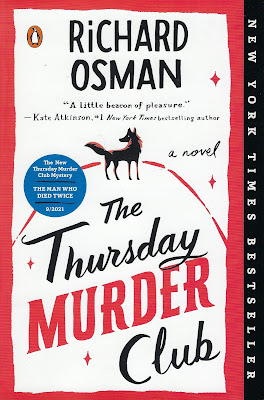I had a nice month of reading in September. Only fiction and mostly crime fiction. I did read one cross-genre book, the first one on my list below.
I noted that most of the books I read were published after 1999; the same thing happened last month. I seem to be tending in that direction lately. Not sure why.
And these are the books I read:
Science Fiction / Mystery
Head On (2018) by John Scalzi
This book qualifies as both science fiction and mystery and in this case the mystery actually supersedes the science fiction, in my opinion. It is the second book in a two-book series set in the near future. The story begins about 20 years after the world-wide epidemic of a virus which causes Lock In syndrome. Technological breakthroughs have been developed to the point where the victims of the disease can use a robotic device to move around, talk, and function in society while their bodies are lying in a bed elsewhere. See my thoughts on the book here.
Crime Fiction
The Tenderness of Wolves (2006) by Stef Penney
I read this for my Canadian Reading Challenge. Set in 1867, primarily in a small settlement in the Northern Territory. There are treks into even more remote areas to search for a murderer. This is a historical mystery, but the crime and the investigation are not primary to the story. The focus is even more on the setting, the prominence of the Hudson Bay Company, and the treatment of Native American trappers. There are a lot of characters to keep up with. I loved it and the ending worked well for me.
Crazybone (2000) by Bill Pronzini
I have been reading the Nameless Detective series by Pronzini since the mid-1970s. I introduced my husband to them in the early 80s after we got married, and he became a bigger fan than I am. He has read all 41 books in the series. I have only read the books up to and including Crazybone, and I still have 15 books left to read. They are short and quick reads; serious stories and sometimes dark. There is humor along the way and the main character ages and develops. Getting back to reading this series seems like meeting an old friend that I haven't seen for years.
The Sanctuary Sparrow (1983) by Ellis Peters
This is the fourth Brother Cadfael book that I have read, but it is the seventh book in the series. The setting for the books in the series is between 1135 and 1145 in England and Wales, primarily. Brother Cadfael takes care of the plants for the monastery and is an herbalist. If this book is typical of the series, it seems like they can be read in any order. However, I plan to get back to reading them in order when possible.
A Killer in King's Cove (2016) by Iona Whishaw
This is a historical mystery set in British Columbia, Canada right after World War II. The heroine, Lane Winslow, has just moved to Canada from the UK, following World War II, and lives in a small town in a home she purchased. After Lane has settled down in King's Cove, a stranger is found dead in the creek that feeds water to her property. Eventually the death is determined to be murder and Lane Winslow appears to have a connection to this man. Another book which was read for the Canadian Reading Challenge. See my review here.
Spycatcher (2011) by Matthew Dunn
I purchased this book at the book sale in September, knowing nothing about it other than it was the first book in an espionage series. It was a fast-paced, action packed story, one you can imagine being turned into a film. A bit too much like the James Bond movies for me, but in the end I enjoyed it and plan to give the second book in the series a try. My main complaint was that the first two or three chapters introducing the protagonist and his handlers were awkward and unconvincing. But I am a sucker for any type of spy fiction, and the rest of the book was much better and held my interest. I have purchased the second book in the series.
Currently reading
Last night, I finished reading The Listening House by Mabel Seeley, a mystery published in 1938, set in a boarding house, one of my favorite settings in fiction, along with hotels and trains. I chose to read it in October because the eerie atmosphere would fit the mood of the R.eaders I.mbibing P.eril event. I haven't picked my next read yet.
I am still reading Anna Karenina, and I doubt I will finish that book before the end of October.
We have started walking in various areas around Santa Barbara a few days a week. This week we went to Stow House, a historic site in Goleta. My husband took the photos at the top and bottom of this post on our walk. Click on the images for the best viewing quality.






























